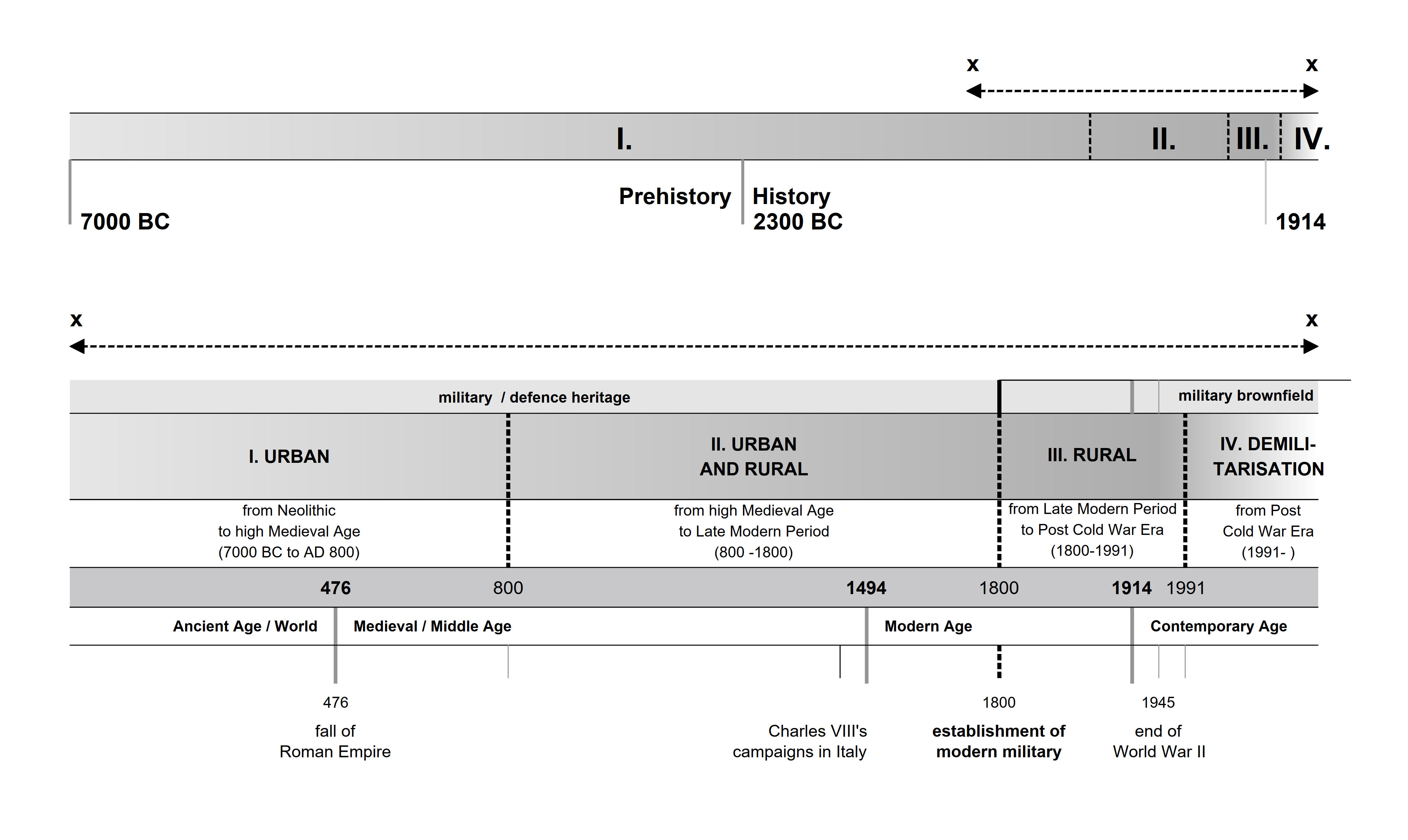Historical Development of Military Sites and Their Impact on Urban and Rural Land Use in the European Context
Exploring the Social Context and Spatial Footprint
DOI:
https://doi.org/10.31522/p.31.2(66).9Keywords:
demilitarisation, historical analysis, military transformation, spatial integration, urban developmentAbstract
This study explores the historical development of military sites and their impact on land use in the European context. Reflecting broader social, political, and technological changes, the impact of military sites on urban and rural areas has undergone a notable transformation. By employing qualitative research methods, this study investigates demilitarisation challenges, transformations, and the integration of military sites into urban environments. It reveals societal perceptions, regulatory complexities, and spatial dynamics, thereby illuminating the potential of repurposing military sites for sustainable urban development. It uncovers the interplay between the military and civilian spheres through nuanced analysis, offering valuable insights into modern city development strategies. As this research unveils historical dynamics, it also provides crucial knowledge that can be employed in planning the future development of cities, considering the evolving relationship between military and urban spaces.
References
Ashworth, G.J. (1991) War and the City, London, New York, Routledge.
Bagaeen, S. (2006) “Redeveloping Former Military Sites: Competitiveness, Urban Sustainability and Public Participation”, Cities, 23, pp. 339-352. https://doi.org/10.1016/j.cities.2006.05.002
Bagaeen, S.; Clark, C. (2016) Sustainable Regeneration of Former Military Sites, Routledge, New York. https://doi.org/10.4324/9781315621784
Blumenson, M. (1980) “Review of The Development of the Modern Military, by Jacques Van Doorn, Maury D. Feld, and G. Teitler”, Armed Forces & Society, 6, 4, pp. 670-82. http://www.jstor.org/stable/45346214, https://doi.org/10.1177/0095327X8000600410.
BMfUNR (1997) Nachnutzung vormals militärisch genutzter Liegenschaften, Study, Bundesministerium für Umwelt, Naturschutz und Reaktorsicherheit.
Brzoska, M.; Franko, P.; Husbands, J. (2000) Typology of Military Assets, Bonn International Center for Conversion - paper 16, Bonn.
Caforio, G. (2006) Introduction. In: Handbook of the Sociology of the Military (Ed. Caforio, G.), Springer, New York, pp. 3-6. ISBN 978-3-319-71602-2. https://doi.org/10.1007/0-387-345760_1
Clark, C.; Brebbia C.A. (2012) Defence Sites Heritage and Future, Wessex Institute of Technology, UK.
Childs, J. (1997) “A Short History of the Military Use of Land in Peacetime”, War in History, 4(1), pp. 81-103. https://doi.org/10.1177/096834459700400105
Delfino, D.; Cardoso, D.; Cruz, G.; Coimbra, F. (Eds.) (2020) Late Prehistoric Fortifications in Europe: Defensive, Symbolic and Territorial Aspects from the Chalcolithic to the Iron Age: Proceedings of the International Colloquium ‘FortMetalAges’, Guimarães, Portugal, Oxford, Archaeopress, 256 p. ISBN: 9781789692556
Dudley, M.Q. (2001) “Sprawl as Strategy: City Planners Face the Bomb”, Journal of Planning Education and Research, 21, pp. 52-63. https://doi.org/10.1177/0739456X0102100105
Foucault, M. (1986) “Of other spaces”, Diacritics 16(1), pp. 22-27.
Furholt, M. (2016) “Settlement layout and social organisation in the earliest European Neolithic”, Antiquity, 90(353), pp. 1196-1212. https://doi.org/10.15184/aqy.2016.170
Giddens, A. (1987) The Nation State and Violence: Volume Two of A Contemporary Critique of Historical Materialism, Berkeley and Los Angeles: University of California Press. Hercik, J.; Szczyrba, Z. (2012) “Post-military areas as space for business opportunities and innovation”, Prace Komisji Geografii Przemysłu Polskiego Towarzystwa Geograficznego, 19, pp. 153-168. https://doi.org/10.24917/20801653.19.12
Hirst, P. (2001) War and Power in the 21st Century, Cambridge: Polity Press.
Hirst, P. (2005) Space and Power, Politics, War and Architecture, Cambridge: Polity Press.
Hooks, G.; Rice, J. (2005) War, Militarism, and States. The Insights and Blind Spots of Political Sociology. In: Janoski, T. et al. (Eds.), The Handbook of Political Sociology States, Civil Societies, and Globalization, Cambridge: Cambridge University Press, pp. 566-584. https://doi.org/10.1017/CBO9780511818059.030
Hughes, Q. (1991) Military Architecture: The art of defence from earliest times to the Atlantic Wall, Beaufort Books Publishers, Liphook, Hants, UK. ISBN 1-85512-008-9
Kádár, K. (2014) “The rehabilitation of former Soviet military sites in Hungary”, Hungarian Geographical Bulletin, 63(4), pp. 437-456. https://doi.org/10.15201/hungeobull.63.4.5
Kardov, K. (2015), Vojni prostori u Hrvatskoj, Hrvatska sveučilišna naklada, Zagreb.
Katzsch, M. (2007) Risk Assessment for the Former Military Training Area “Döberitzer Heide”. In: Spyra, W.; Katzsch, M. (Eds) Environmental Security and Public Safety: Problems and Needs in Conversion Policy and Research after 15 Years of Conversion in Central and Eastern Europe, Springer, Dordrecht, pp. 59-70. https://doi.org/10.1007/978-1-4020-5644-4_6
Keogh, T. (2019) Chapter 1 Introduction. In: Keogh, T. (Ed.) War and the City, Leiden, The Netherlands: Brill | Schöningh, pp. 1-16. https://doi.org/10.30965/9783657702787_002 [Accessed 29 July 2022]
Jukić, T.; Mrđa, A.; Perkov, K. (2020) Urbana obnova : urbana regeneracija Donjega grada, Gornjega grada i Kaptola - povijesne urbane cjeline Grada Zagreba, Zagreb, Arhitektonski fakultet Sveučilišta u Zagrebu.
Lang, K. (1965) “Military Sociology”, Curent Sociology 13(1), pp. 1-26. https://doi.org/10.1177/001139216501300101
Malešević, S. (2011) Sociologija rata i nasilja, Naklada Jesenski i Turk, Zagreb.
Mandarino, A.; Luino, F.; Turconi, L.; Faccini, F. (2020) “Urban geomorphology of a historical city straddling the Tanaro River (Alessandria, NW Italy)”, Journal of Maps, pp. 1-13. https://doi.org/10.1080/17445647.2020.1746420
Matković, I.; Jakovčić, M. (2019) “Brownfield prostori i njihova regeneracija; Definicije i pristupi”, Prostor, 27(2/58/), pp. 348-359. https://doi.org/10.31522/p.27.2(58).13
Matković, I.; Jakovčić, M. (2020) “Prenamjena i održivo korištenje napuštenih vojnih prostora u Urbanoj aglomeraciji Zagreb”, Hrvatski geografski glasnik, 82(2), pp. 81-106. https://doi.org/10.21861/HGG.2020.82.02.03.
Ministry of Defence Annual Report and Accounts 2020-21, 2022, UK.
Moskos, C.C. (1977) “From Institution to Occupation: Trend sin Military Organization”, Armed Forces and Society, 4(1), pp. 41-50. https://doi.org/10.1177/0095327X7700400103
Moskos, C.C.; Williams, J.A.; Segal, D.R. (2000) The Postmodern Military: Armed Forces After the Cold War, Oxford University Press, New York.
Mosse, G.L. (1991) Fallen Soldiers, Reshaping the Memory of the World Wars, Oxford University Press, New York. https://doi.org/10.1093/oso/9780195071399.001.0001
Mumford, L. (1961) The City in History - Its Origins, Its Transformations, and Its Prospects, Harcourt Brace Jovanovich, Inc., New York.
Mumford, L. (1970) The Culture of Cities, A Harvest/ HBJ Book, San Diego, New York, London.
Speier, H. (1941) “Magic Geography”, Social Research, 8(3), pp. 310-330.
Stearns, P.N. (2013) Demilitarization in the Contemporary World, University of Illinois Press.
Tracy, J.D. (Ed.) (2000) City Walls: The Urban Enceinte in Global Perspective. Cambridge:
Cambridge University Press, ISBN 0-521-65221-9. Middle East Studies Association Bulletin, 37(2), pp. 307-307. https://doi.org/10.1017/S0026318400046253
Virilio, P. (2005) Desert Screen: War at the Speed of Light, Continuum, London.
Wallwork, K.L. (1974) Derelict Land: Origins and Prospects of a Land-Use Problem, David and Charles, London.
Woodward, R. (2004) Military Geographies, Blackwell Publishing Ltd, UK. https://doi.org/10.1002/9780470774793
Woodward, R. (2014) “Looking at Military Landscapes: Definitions and Approaches”, Contributions to Conflict Management, Peace Economics and Development, 23, pp. 139-153. https://doi.org/10.1108/S1572-832320140000023010

Downloads
Published
Versions
- 2024-04-09 (2)
- 2023-12-27 (1)
How to Cite
Issue
Section
License
Copyright (c) 2023 Kristina Perkov, Tihomir Jukić

This work is licensed under a Creative Commons Attribution 4.0 International License.
Copyright (c) 2021 authors and journal.
This work is licensed under a Creative Commons Attribution 4.0 International License.
Authors who publish with this journal agree to the following terms:
In agreeing this form, you certify that:
- You read the ethical codex of the PROSTOR available at journal web.
- You submitted work is your original work, and has not previously been published and does not include any form of plagiarism.
- You own copyright in the submitted work, and are therefore permitted to assign the licence to publish to PROSTOR.
- Your submitted work contains no violation of any existing copyright or other third party right or any material of an obscene, libellous or otherwise unlawful nature.
- You have obtained permission for and acknowledged the source of any illustrations, diagrams or other material included in the work of which you are not the copyright owner.
- You have taken due care to ensure the accuracy of the work, and that, to the best of your knowledge, there are no false statements made within it.
- All co-authors of this submitted work are aware of, and in agreement with, the terms of this licence and that the submitted manuscript has been approved by these authors.






